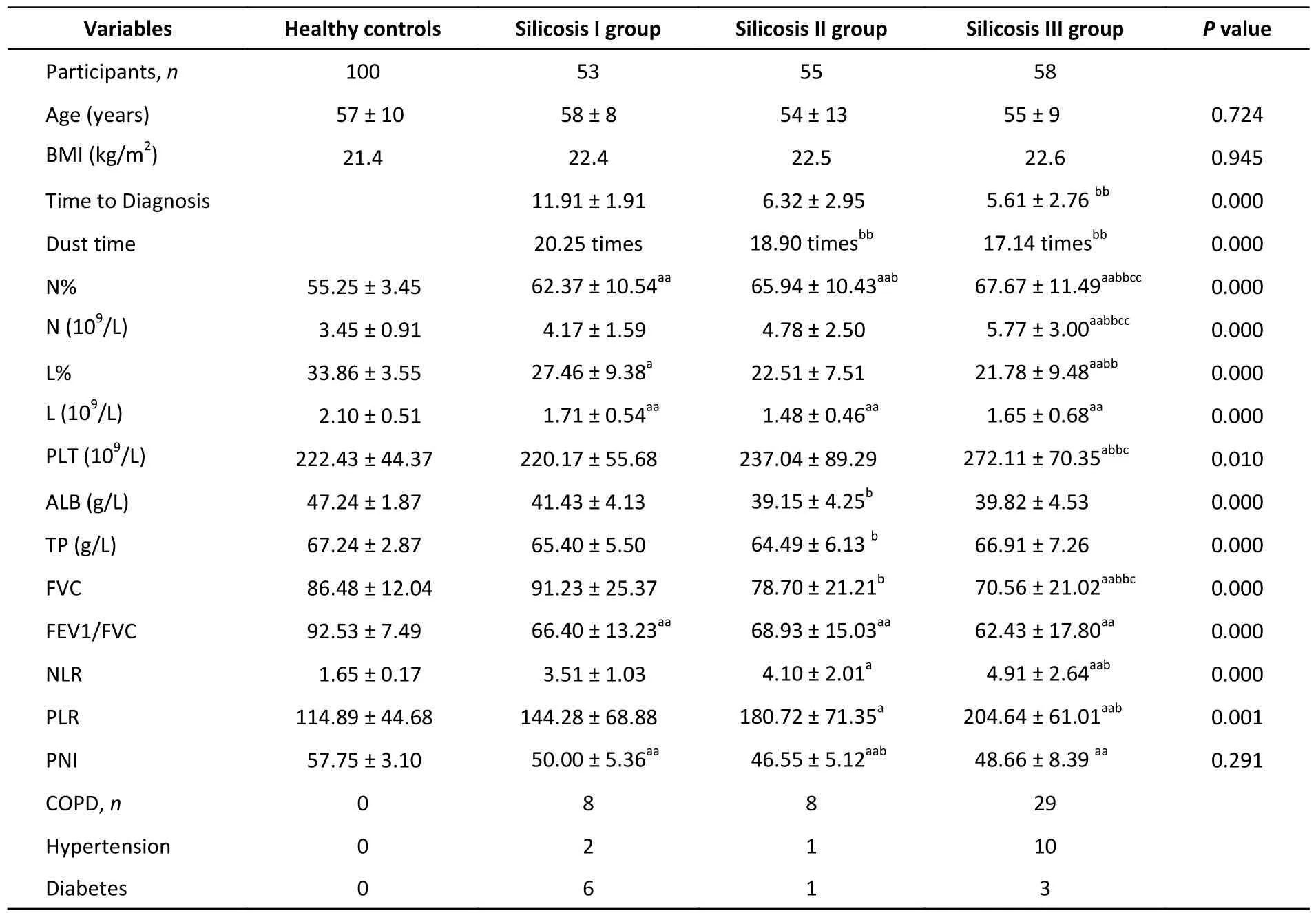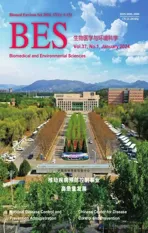Prognostic Nutritional lndex Associates with the Severity of Silicosis: A Study from a Tertiary Class A Prevention and Treatment lnstitute for Occupational Diseases in China*
2024-02-26HELaGuLIANGYunLaiYANGLuQiandYUANHuaMin
HE La Gu, LIANG Yun Lai, YANG Lu Qi, and YUAN Hua Min,#
Pneumoconiosis is a group of heterogeneous fibrotic lung diseases caused by inorganic mineral dust and includes coal workers’ pneumoconiosis and silicosis.Silicosis involves diffuse or nodular interstitial pulmonary fibrosis caused by exposure to asbestos or silica dust.China is thought to have the highest number of silicosis cases, with 6,000 new cases reported annually[1].Currently, the clinical diagnosis and monitoring of silicosis relies mainly on a history of occupational exposure and radiological abnormalities[2].Therefore, determining further indicators is crucial to reflect the severity of silicosis.
Malnutrition is generally associated with immune dysfunction—inflammatory processes that directly increase the incidence of complications.Nutritional assessment tools such as the Prognostic Nutritional Index (PNI), Nutritional Risk Index (NRI), and Geriatric Nutritional Risk Index have shown promise as prognostic indicators for various diseases.The PNI, calculated using the serum albumin level and total lymphocyte count in the peripheral blood, was originally proposed to assess the perioperative immunonutritional status and surgical risk of patients undergoing gastrointestinal surgery[3].The severity of silicosis as a chronic wasting disease may also be related to nutritional status.A previous study conducted by the authors of this study showed that neutrophil-to-lymphocyte ratio (NLR) and plateletto-lymphocyte ratio (PLR) can be used as indicators of inflammatory state and severity in the clinical prognosis of patients with silicosis[4].Therefore, this study intends to explore the value of PNI in evaluating prognosis in silicosis and efficiently facilitating risk stratification to guide treatment decisions among clinicians.
This was a case-control study of silicosis patients evaluated at the Hunan Prevention and Treatment Institute for Occupational Diseases from January to December 2022.Body mass index (BMI) is the ratio between body weight in kilograms and squared body height in meters (kg/m2).The diagnosis of silicosis was based on the diagnosis of occupational pneumoconiosis (GBZ70-2015)[5].The diagnostic criteria of silicosis define the stage of silicosis as consistent with the severity of silicosis, with higher staging corresponding to more severe disease.Furthermore, silicosis is divided into three phases:silicosis stages I, II, or III.A total of 166 patients(male) diagnosed with silicosis were included in the study.All patients were coal mine workers in Hunan Province and over 75 years old.Those with lung cancer, pulmonary tuberculosis, pulmonary heart disease, and lung diseases unrelated to silicosis were excluded.The control group included 100 age and sex-matched volunteers without comorbidities who worked in dust-related occupations.
Fasting blood samples were collected from silicosis patients and occupational health examiners in the morning.After, samples underwent 3500 r/min centrifugation for 5 minutes.After separating the serum, the Sysmex XN-2000 Haematology Analyzer(Sysmex, Milton Keynes, UK) measured leukocytes(WBC), mean platelet volume (MPV), neutrophils (N),lymphocytes (L) and platelets (PLT).Total protein(TP) and albumin (ALB) were evaluated using the Hitachi 7600 Automatic Biochemistry Analyzer(Hitachi, Ltd).Pulmonary function tests were performed using the Spirometer MSA99 (M&B Co).The PNI score was calculated using the following formula: serum albumin value [g/L]) + (5 ×lymphocyte count [109/L])[3].
Statistical analysis was conducted using an online statistics tool (http://dxonline.deepwise.com/) and R software (Version 4.0.1) with pROC and Rattle package.Multifactor regression analysis was used to screen for risk factors of silicosis.Following the results of multifactor regression, the machine learning method was used to build a column-line model to predict the risk of silicosis.A receiver operating characteristics (ROC) curve was used to evaluate the diagnostic value.A two-tailedPvalue of less than 0.05 was considered statistically significant[6].
Table 1 describes the clinical and biochemical characteristics of the study participants.No difference was observed in age (P= 0.724) and BMI(P= 0.945) among the four groups.Serum N%, N, L%,L, PLT, TP, ALB, forced vital capacity (FVC), and ratio of forced expiratory flow in 1 second to forced vital capacity (FEV1/FVC) levels differed significantly difference among the four groups (P< 0.001).Meanwhile, the silicosis III group had lower L%, N%,N, PLT, and FVC levels than the silicosis I and control groups.Furthermore, the silicosis II group had lower N%, L, and FEV1/FVC levels than those of the control and lower N%, TP, ALB, and FVC levels compared with those of the silicosis I group.The silicosis I group had lower N%, L%, L, and FEV1/FVC levels compared with those of the control group.
Figure 1 illustrates the correlation of all indicators in this study, focusing on the correlation between the most important nutritional indicator—PNI— and other indicators.PNI was significantly associated with all variables except MPV and is significantly correlated with L, N, and ALB.Meanwhile, PNI negatively correlated with age,WBC, PLT, NLR, and PLR and positively correlated with FVC and FEV1/FVC.These results suggest thatnutritional status may be related to silicosis.

Table 1.Clinical and biochemical characteristics of the study participants
FEV1/FVC, the most important indicator of lung function, was designated the independent variable;other indicators were designated dependent variables during multiple linear regression analysis.As shown in the regression residual scatter plot(Supplementary Figure S1, available in www.besjournal.com) and multiple linear regression of FEV1/FVC (Supplementary Table S1, available in www.besjournal.com), the residuals are randomly distributed near the center line, indicating that the errors are randomly distributed when the regression model is well-fitted.The R2value of the model was 0.523, indicating that the indicators included in the model accounted for 52.3% of the total influencing factors of FEV1/FVC in patients.As such, PNI and other indicators have a crucial impact on lung function in silicosis patients.
As shown in Supplementary Table S2 (available in www.besjournal.com), a single factor plus multiple factor logistic regression analysis was conducted to screen the risk factors of silicosis, with the disease as the dependent variable and the other variables as the independent variable.The indices with significant differences in the univariate analysis were included in the multivariate analysis.After excluding collinearity, the multivariate regression model showed that the increase in NLR and decrease in FEV1/FVC and PNI scores were independent risk factors for silicosis.
Based on the indicators screened by multivariate analysis, a warning model was established through machine learning.The probability of PNI, PLR, NLR,and FEV1/FVC were estimated using the nomogram(Supplementary Figure S2, available in www.besjournal.com).The clinical indicators were located on each variable axis, and a vertical line was drawn from that value to the top point scale to calculate the score for each predictor.The AUC of the warning model was 0.980.The area under the ROC curve of NLR, PLR, FEV1/FVC, and PNI for silicosis were 0.866,0.731, 0.955, and 0.908, respectively (Figure 2).In summary, PNI combined with PLR, NLR, and FEV1/FVC is a better model for predicting the risk of silicosis.

Figure 1.Correlation analysis heat map with differential indicators.

Figure 2.ROC curve of multivariate joint prediction of silicosis (A) and NLR, PLR, FEV1/FVC, and PNI evaluating disease activity in patients with silicosis (B), respectively.
Silicosis is a chronic, progressive, incurable lung disease characterized by the accumulation of fibroblasts and chronic inflammation.NLR and PLR have been consistently validated worldwide as measures of the inflammatory response[7].This study revealed the characteristics of PNI and other common clinical inflammatory indicators in silicosis patients.
In this study, the levels of L%, L, ALB, FVC, and FEV1/FVC in silicosis patients were significantly lower than in the control group (P< 0.05),suggesting that silicosis is a chronic wasting disease.Further, the lung function of silicosis patients is worse than those in the control group.This is consistent with previous results of the authors of this study[4].Further correlation analysis revealed that PNI was significantly associated with all variables except MPV.PNI is significantly correlated with L, N, and ALB; it is negatively correlated with age, WBC, PLT, NLR, and PLR and positively correlated with FVC and FEV1/ FVC.These results suggest that nutritional status may be related to silicosis.Further, multiple linear regression analysis revealed that PNI and other indicators have a more substantial impact on lung function in silicosis patients.The multivariate regression model showed that the increase in NLR and the decrease in FEV1/FVC and PNI scores were independent risk factors for silicosis.A warning model relying on machine learning suggests that PNI combined with other clinical indicators is a better model for predicting the risk of silicosis.
The role of PNI as an indicator of disease is consistent with the results of many studies[8-9].In clinical work, judging the severity of disease in silicosis patients is comprehensive and complex.Silicosis is a chronic wasting disease caused by longterm exposure to dust.PNI as an indicator to evaluate the degree of nutrition can be a good assessment of the severity of silicosis.
In summary, PNI can be used as an indicator of clinical prognosis and severity of silicosis patients.
Conflict of InterestThe authors declare no conflict of interest.
Author ContributiomHE La Gu designed the study and wrote the manuscript.LIANG Yun Lai examined the data and revised the manuscript.YANG Lu Qi collected and analyzed the data.YUAN Hua Min supervised the participants and revised the manuscript.
&These authors contributed equally to this work.
#Correspondence should be addressed to YUAN Hua Min: E-mail: Helagu2015@sina.com Tel/Fax: 86-731-85303154.
Biographical notes of the first authors: HE La Gu,female, born in 1991, MA, majoring in pneumoconiosis and inflammation; LIANG Yun Lai, male, born in 1991, MA,majoring in clinical biochemistry.
Received: July 20, 2023;
Accepted: November 13, 2023
杂志排行
Biomedical and Environmental Sciences的其它文章
- Correlation between Combined Urinary Metal Exposure and Grip Strength under Three Statistical Models: A Cross sectional Study in Rural Guangxi*
- Effects of Bisphenol A and lts Substitute, Bisphenol F, on the Gut Microbiota in Mice*
- The Uptake and Distribution Evidence of Nano- and Microplastics in vivo after a Single High Dose of Oral Exposure*
- The Effect and Mechanism of Fructus lycii on lmprovement of Exercise Fatigue Using a Network Pharmacological Approach with in vitro Experimental Verification*
- Quercetin Alleviates Lipopolysaccharide-lnduced Cardiac lnflammation via lnhibiting Autophagy and Programmed Cell Death*
- Exosome-Transmitted miR-224-5p Promotes Colorectal Cancer Cell Proliferation via Targeting ULK2 in p53-Dependent Manner*
